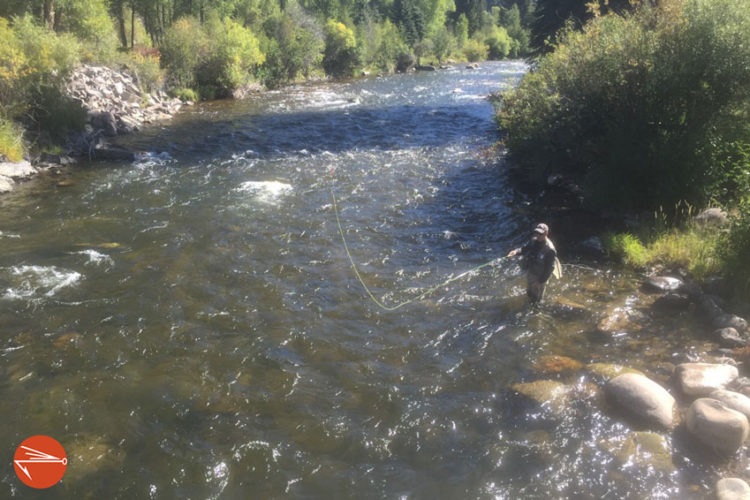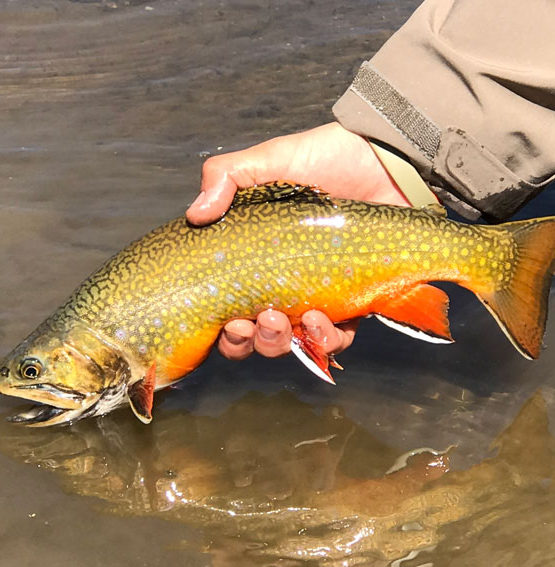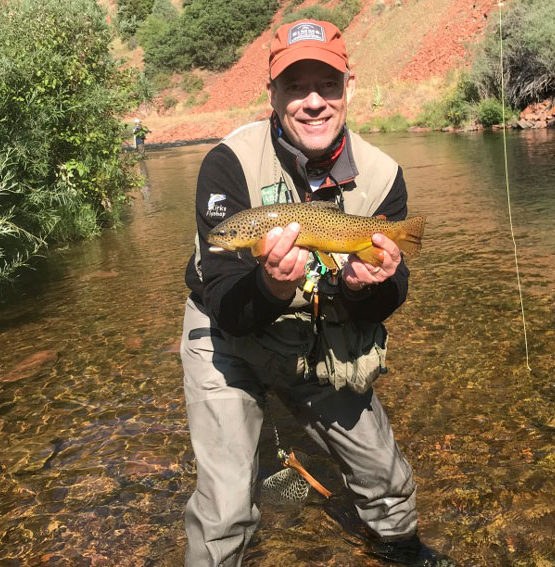In this post, I’m going to cover 10 simple wading tips to keep you safe on your next fishing adventure. So, whether you are a novice without any wading experience, or an experienced angler in need of a couple reminders, stick around.
One of the great joys of angling is the serenity and calm that comes with wading through your favorite body of water in search of that next catch of the day. What makes this pastime so enjoyable are the countless opportunities to tune out the noise and reconnect with yourself and with nature.
However, as inviting as it may seem, there are a few wading tips and rules that should be followed not only for effective results, but for the safety of the person behind the rod and reel. So, in an effort to help you get the most out of your next fishing adventure, here are our top 10 wading tips to keep you safe (and dry).
Let’s wade in.
Disclaimer: This post may contain affiliate links, meaning we will receive a small commission (at no cost to you) if you click through and make a purchase.1. Use A Wading Staff
A wading staff is an essential piece of equipment for those fishing in bodies with fast water, jagged shores, and slippery beds.Therefore, before your next fishing trip, consider purchasing a wading staff. It’s natural to feel strong and agile enough to navigate streams and rivers without assistance, but staffs are important regardless of your experience level. An expertly designed staff provides security and stability to anglers wherever they are fishing.
What’s more, you don’t need to spend an arm and a leg.
If you find yourself out in the wilderness without a staff, there are plenty of items that can serve as a stand-in. Large sticks, ski poles, shovel handles––anything that can give you a sure footing. For extra confidence, tie a length of cord to your makeshift item and you’ve got a solid wading staff in a pinch.
Anything that keeps you upright and safe is better than nothing.
Related Posts:
- Fly Fishing Without Waders: 6 Essential Tips
- 7 Essential Things To Look For In A Fly Box
- What To Wear Under Waders In Summer
- Is Fly Fishing Hard To Learn? (The Truth)
- How To Read A River: 9 Tips To Catch More Trout
2. Take It Slow
When fishing, it is important to acknowledge that individual comfort levels vary and what works for one person might not for the other.
Therefore, you should never attempt to wade into choppy or fast-moving waters that exceed your comfort level. Rather, you should always take a slow and steady approach. In other words, don’t be in a rush to cross a section of water that may end in disaster. As much as you want to catch that next fish, it isn’t worth the risk of drowning.
Know your limits and stay within them.
3. Plan Your Wading Route
No two bodies of water are the same. Some are deep, some are shallow, some are clear and some are dirty. And since water levels rise and fall throughout the year, rivers and streams are constantly changing. So, even if you are familiar with a particular area, it’s best to have a game plan.
Always take note of your surroundings and anticipate hazards.
Additionally, learn to read the water (this, admittedly, comes with a few years of experience) and be on the lookout for obstacles before you wade in the water. Many experienced anglers, myself included, have waded out into a seemingly calm area, only to be surrounded by deep pools that can become treacherous.
Consider the worst-case scenario for each substantial movement, for example:
- What will happen if you lose your footing?
- Are there any dangerous sections of river directly downstream if you were to fall in?
- What if you get caught up in a riptide––how will you navigate back to the surface?
If you can create an effective plan before approaching any fishing site, you’ll be that much better prepared for challenges before they become catastrophes.
4. Know Where Your Stand
Before entering open water, you should have a basic understanding of water safety.
Knowing which direction to face and how to stand/step while wading is fundamental.
When your lower body is submerged, rather than lifting your feet with each step, try trudging or shuffling atop the rocky bottom of the stream. This is safer than simply walking because you avoid the risk of the current pushing your leg out from under you. Maintaining a firm balance and solid footing is the first step of safe wading.
If, however, you do manage to get swept off your feet, flip yourself onto your back and aim your feet downstream to prevent more sensitive body parts from colliding with foreign debris and rocks. Once it’s safe, turn yourself in at a 45-degree angle towards the current and swim towards the shore.
5. Wear A Wading Belt (And Tighten It Up)
A wading belt is one of the most important pieces of gear you can wear. Why? Quite simply, because it can save your life.
A wading belt prevents water from quickly filling your loose-fitting waders. No matter your level of expertise, if you end up falling or accidentally wading into a section of water that fills your waders from the top, you can be pulled under and submerged within a matter of seconds. Always play it safe and wear a nice, tight wading belt.
6. Use Studded Wading Boots
There is perhaps no greater tool for safely navigating the waters––whether choppy or calm, familiar or foreign––while angling then a solid pair of wading boots. There are a few varieties to choose from, however, for the best possible footing, opt for a pair with studded soles.
Studs, or cleats as they’re sometimes called, effortlessly grab the sand and rock beds, in situations where plain rubber soles are likely slip.
These days, most wading boots have removable studs, which is really nice for a couple reasons. First of all, if you plan on wearing your wading boots in a boat (or indoors), studs are a no-no. Trust me, fiberglass (or hardwood floors) and studded wading boots aren’t a good combination. Secondly, if you ever find yourself caught in a lightning storm while fishing, it’s nice to have the ability to remove the metal “grounding” studs from your feet while you wait it out. Just sayin’.
7. Use Polarized Sunglasses
Knowing where you should and shouldn’t step is half the battle when wading. And when you can’t see the riverbed, you are basically wading blind. The good news is that polarized lenses solve this problem.
Polarized fishing sunglasses not only protect your eyes from the sun’s intense rays reflecting off the water, but they also improve your ability to see where you are wading by filtering out the surface glare on the water. Plain and simple, polarized lenses make wading a much safer process.
Plus, beyond just wading, polarized lenses allow you to see the fish, your flies, and your strike indicator much easier. So, if you don’t own a pair of polarized sunglasses, you should go buy a pair right away.
8. Avoid Distractions
Fly fishing is a surprisingly cerebral process. Of course, there are physical elements involved, but no matter how strong you feel, if your mind is clouded with distracting thoughts when you arrive at the water, you may not only end up missing a few takes, but risking your life.
Whether you are preoccupied with stress, or just watching a bald eagle soar directly above you, when you’re wading, anything that draws your focus away from the task at hand can lead to disaster.
Put simply, distracted wading is dangerous wading. So, maintain your focus, and save the distractions for dry land.
9. Avoid Fast-Moving Currents
This one goes hand-in-hand with planning your wading route, but it is also important enough to deserve its own spot on the list.
If you don’t have much wading experience, it’s easy to underestimate the power of fast-moving water, but trust me, it’s an unbelievably powerful force. So, whenever you’re wading, do your best to avoid fast-moving current.
It can be a truly unnerving experience to wade out into swift current and find yourself struggling to maintain your balance.
Use common sense: if you look out onto the river and see that the current is moving faster than normal, avoid it––even if it’s relatively shallow. If, however, you are already in the water and you find yourself in a fast-moving section, don’t chicken out. The worst thing you can do is let your fear take over. Just take it one step at a time, and stay focused.
10. Use The Buddy System
As with any outdoor adventure, one of the smartest things you can do when wading is to use the buddy system. Seriously, the buddy system can mean the difference between a timely rescue and a terrible accident. By sharing your outdoor experience with a friend, you are not only creating lasting memories that you can both reflect on for years to come, but you are also protecting yourself from unforeseeable hazards.
So there you have it! 10 simple wading tips to keep yourself safe and dry on your next fishing trip. I hope these suggestions will help you to better prepare for all that nature has in store.
In the meantime, happy wading!
Other Related Posts:











I’ve read a few of your articles and I find your common-sense writing is very relatable and practical. Great for novice or those stepping-up their game. I often fish alone and enjoy the solitude and challenge and you’ve helped me be a wiser more informed river/stream fishermen. Larry from Wisconsin
Thanks for the comment, Larry! Let me know if there’s any other content you’d like to see on FFF!